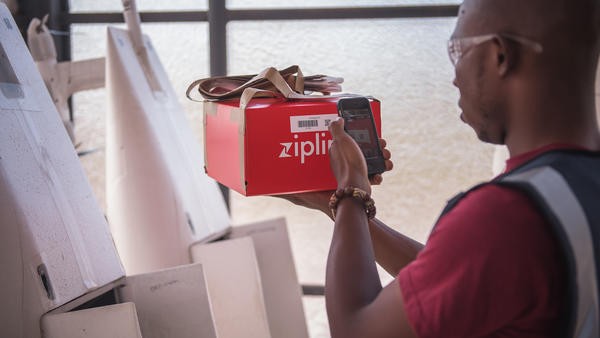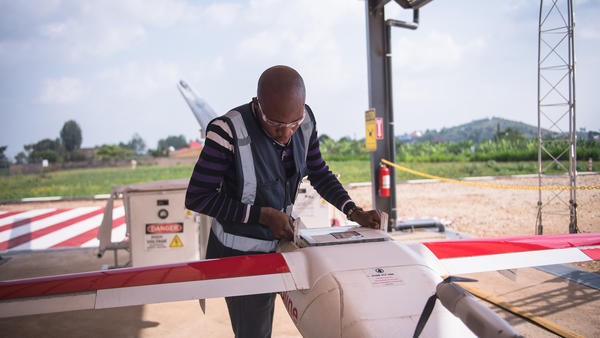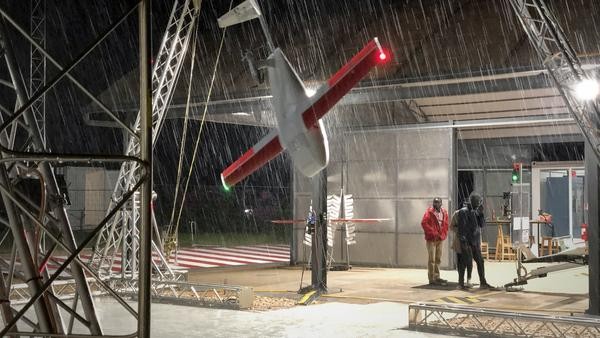Special Report: Zipline International blood drone delivery service

AirMed&Rescue takes a look at air medical drone delivery service Zipline International (Zipline), the work that it does and how it is currently pioneering improved access to healthcare in Sub-Saharan Africa
A Zipline operations image gallery is available at the end of this article.
An overview of operations
Zipline currently uses drones to deliver blood supplies to hospitals across Rwanda and Ghana, having been established in 2014 by Co-Founders Keller Rinaudo and Keenan Wyrobeck, respectively the CEO and Head of Product & Engineering of the company.
Countries need to have enough surplus blood in the event of surges in demand and situations such as natural disasters and other mass-casualty events
Created with the aim of providing access to vital health products in less developed countries (both in terms of economy and infrastructure), Zipline was initially launched in Rwanda, where it erected a distribution centre in the region of Muhanga. From this central base, Zipline was able to launch (quite literally) its blood-carrying drones across the west of Rwanda, parachuting down vital blood products (including cells, platelets and plasma) to hospitals in need of the additional supplies.
Since opening its first base in Muhanga, Zipline has grown to operate a second distribution centre in eastern Rwanda, and it is now able to serve the whole of the country and deliver additional products between its bases. Today, the Rwandan Government has outsourced the majority of the country’s blood delivery to Zipline.
As of this April, the company has also expanded into Ghana, where it is delivering medical supplies on behalf of the Government to 2,000 health facilities, serving 12 million people across the country. Zipline currently has three bases positioned in the south of the country (where the population is much denser) – one of them being in Omenako, near the capital, Accra. A fourth base serves the remote north region (where the population density is at its lowest). Each base is equipped with 30 drones.

The blood distribution chain
Zipline was founded from a deep concern that poorer countries, particularly those based in areas such as the African continent, do not have access to the vital medical supplies they need to survive – such as blood products, which Western countries are able to access in abundance thanks to their improved infrastructure and wealth.
Because of the disposable nature of the packaging, personnel are not required to drive out to hospitals to collect the parachutes and delivery boxes
When it comes to collecting and distributing blood supplies in wealthier countries such as the US and those in Europe, wastage inevitably occurs. As per the US Food and Drug Administration, red blood cells – the most commonly used blood product – have a shelf life limited to 42 days in the US, 35 days in Europe, and similar numbers in the rest of the world. Recent studies conducted by the National Heart, Lung, and Blood Institute have even suggested that the quality can deteriorate after shorter periods of time, depending on the donor’s genes.
Countries need to have surplus blood in the event of surges in demand and situations such as natural disasters and other mass-casualty events. Because of this, more developed countries have a significant amount of blood wastage (due to blood products expiring before they’ve had a chance to get used), but they are fortunate enough to be able to cover the cost that this wastage incurs. Poorer countries, however, cannot afford the luxury of wasting blood, and therefore need a more practical and innovative solution within their blood distribution chain.
Muhanga – a closer look
Though a relatively poor country, Rwanda operates a universal healthcare system and, as such, provided the perfect location for Zipline to trial its service back when it was first starting out. Roads in Rwanda leave a lot to be desired: predominantly dirt tracks, meaning that driving across the country can become difficult during the rainy seasons (of which there are two – from February to June and September to December), where the roads become impassable for days on end. And this can seriously impede hospitals’ access to vital medicines and blood supplies, when people affected by natural disasters need them most.
Enter Zipline – a catapult-launched drone system that is able to parachute supplies down to hospitals at the touch of a button, across all terrains and adverse weather conditions. Within 15 minutes (for the closer bases), doctors are able to receive the vital supplies that they need to treat their patients; and because hospitals only order what is needed, wastage of these limited blood supplies is kept to the bare minimum.
How it works
In the western half of Rwanda, Zipline drones service 21 hospitals. The closest is 2.5 miles (4 km) from Zipline’s facility in Muhanga, the furthest is 50 miles (80 km) away.
The blood supplies are delivered to Zipline via road from Rwanda’s health system. And any of the hospitals can place an order with Zipline (via email, text, phone, WhatsApp etc.)
Once an order has been placed, the flight ops receive and process it, passing the information onto the next person in the process, while maintaining contact with the hospital in order to let them know when their delivery will arrive.
Roads in Rwanda leave a lot to be desired: predominantly dirt tracks, meaning that driving across the country can become difficult during the rainy seasons, where the roads become impassable for days on end
A health operator will then package up the delivery in a special single-use delivery box; assembled on site from cardboard, bubble wrap and tape, with a parachute being made from paper. Because of the disposable nature of the packaging, personnel are not required to drive out to hospitals to collect the parachutes and delivery boxes.
The packaged product is then passed on to another flight operator, who will take the delivery over to a Zipline drone, scan the QR code on the package to verify the delivery location and correct drone, and the delivery is then placed within the body of the drone.
The drone is then placed upon the catapult instrument, where an operator will fix the wings onto the aircraft, and another will insert the battery pack. The flight operators will then perform a visual check to identify any damage to the drone and also ensure that all moving components are working using an app.
Throughout this process, another flight operator is stationed in the ‘Crow’s Nest’, performing air traffic control for zipline. They are in charge of the drones while they’re flying, and so are constantly in contact with Rwandan Air Traffic Control, ensuring that they have clearance to fly (which usually happens immediately, as the country has low aircraft activity in its airspace). As such, the products aren’t sitting out for long periods of time waiting to take off.
Operations
- A single flight can deliver up to three units of blood (1.8-kg payload) – multiple drones can be sent at the same time for larger orders.
- The zipline aircraft are autonomous and electric, removing the need for pilots, as well as eliminating the emissions involved with transporting medicine.
- Zipline aircraft fly 60 mph (100 kmph) 24/7 in all kinds of weather (wind, rain and severe lightning) and over all kinds of terrain, so the closest hospitals are reached within 15 minutes, and those furthest away are reached within the hour.
- One-third of Zipline’s deliveries are for emergency situations where a hospital is out of stock of a particular blood product that a patient vitally needs.
Once clearance has been given, a flight op will launch the Zipline drone. And once in flight, the drone will follow a pre-set flight path. The aircraft flies high enough that it needs no obstacle avoidance ability and can also enter a pre-set holding flight pattern should it need to clear part of the airspace for air traffic.
As the drone approaches the predetermined delivery zone, the individual in contact with the hospital will let the hospital know their supplies are arriving. The drone will then lose altitude, circle a few hundred feet above the delivery site and drop the package. The parachute slows the fall and any other impact is absorbed by the bubble wrap inside the box. Hospital staff head outside to collect the blood product for use in the facilities.
The drone then gains altitude, flies back to the Zipline distribution base, circles to lose altitude again and then comes in about 15 feet above the ground, before being caught on a wire in mid-air and swinging to a stop at the landing site, ready to be collected by Zipline personnel and go out on its next delivery.
Advanced tech and safety features
There’s also even more to the aircraft than meets the eye. Wyrobeck outlined the many technological attributes of the drones that rigorous testing at the company’s California base had afforded, also touching upon the innovative safety features.
Machine learning technology such as computer vision is used in the pre-flight check to ensure that all components of the aircraft are working in advance of the flight, Wyrobeck explained. This minimises the likelihood of faults occurring whilst the drone is in the air.

In terms of integration into the local infrastructure, the Zipline team is in direct contact with aviation authorities throughout operations, enabling the Rwandan Air Traffic Control team to track every one of Zipline’s flights. Zipline planes use advanced algorithms and software testing to affirm the plane’s location and ensure they know their flight paths and destinations.
The aircraft also have in-built redundancy systems to improve performance and provide a backup of critical components. “The aircraft has two motors. If one stops working it will keep flying on the other one,” said Wyrobeck. “The same is true for our plane’s power, communication and navigation systems.”
Poorer countries cannot afford the luxury of wasting blood
He states that all of the plane’s safety features work automatically onboard the aircraft; from the ground, he says, you wouldn’t even be able to tell they are working. All except one: the parachute landing system.
In an emergency, whereby aviation authorities tell Zipline to immediately clear the airspace, extreme weather impedes the plane’s flight ability, or, on very rare occasions, the plane’s redundancy systems fail, the aircraft will deploy a large parachute allowing it to gently land. And this is where the plane’s other key safety feature comes into play: the frangible design of the aircraft (the Styrofoam shell of the plane and plastic parts of the tail) is designed to break on impact, absorbing the impact and minimising damage caused to anything on the ground. Wyrobeck extrapolated: “Those frangible parts are designed to be easily replaced, so that plane can quickly get back into service, saving lives.”
Operators then head out by road to retrieve any fallen aircraft and take them back to the Zipline base.
“We are committed to making and operating the safest system of its kind in the world,” said Wyrobeck. “People’s lives depend on Zipline, and that’s a responsibility we take very seriously.”

September 2019
Issue
In this issue:
When the lights go out: The challenge of nighttime rescues
Digital dream: MRO software solutions
Interview: Samir Mehta, President of Collins Aerospace’s Mechanical Systems
Case Study: TrustAir reports on a neonatal mission
Industry Voices:
- ICAO Annex 14 amendment – is your helipad ready?
- The cost of reimbursement of emergency medical flights in the US
Special report: Blood delivery by zipline
Med Insight: Airway management training
Robyn Bainbridge
Robyn is a writer with a degree in English Literature and over four years’ experience in creative journalism. She enjoys the inspiring ingenuity of the Gossamer Albatross (as well as the name).








